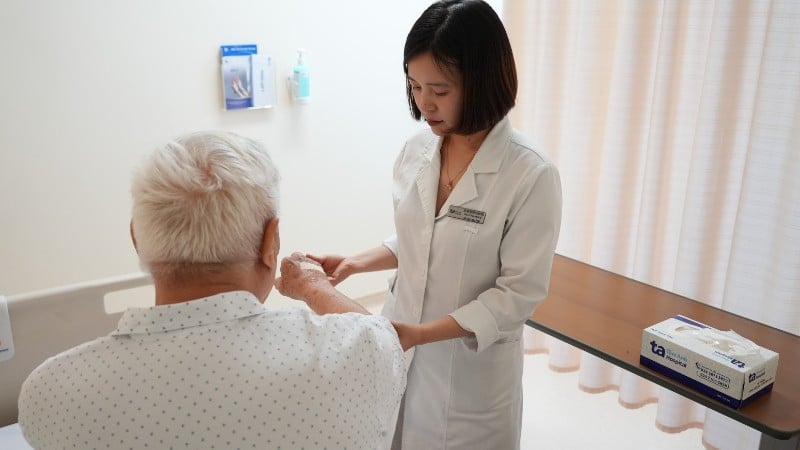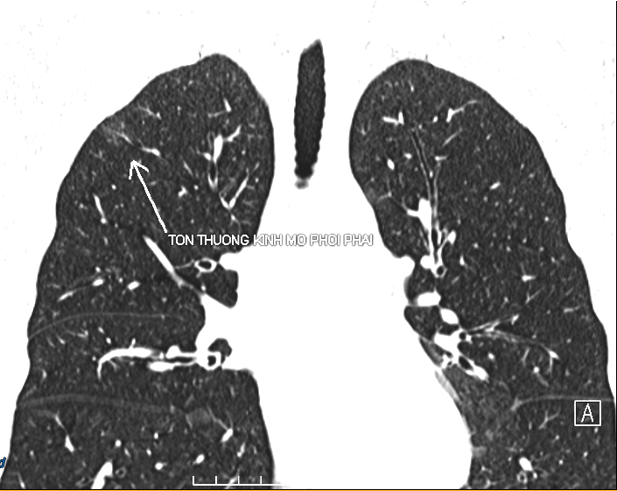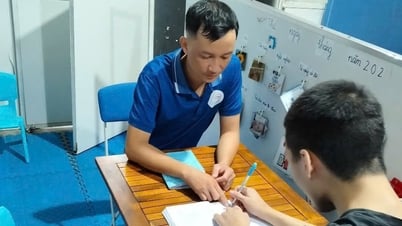
NTD patient had been treated for bronchial asthma, had a history of smoking for more than 20 years, 5-7 cigarettes per day. The patient lost 7kg continuously within 4 months, had been screened for cancer but was not diagnosed. Recently, Mr. D. felt tired, had poor appetite, numbness in both hands and feet, and pain in both calves. The symptoms gradually worsened with chills, fever, and dry cough in the evening, so he went to Tam Anh General Hospital in Hanoi for examination.
Master, Doctor Nguyen Thi Anh Ngoc, Department of Musculoskeletal, Tam Anh Noi General Hospital said that the clinical examination results showed that Mr. Duy had signs of high fever (over 38 degrees Celsius), fatigue, poor appetite, and numbness in the limbs. The doctor ordered the patient to perform some paraclinical tests.
The results showed an elevated eosinophil count of 2.65 G/L (10 times higher than normal), and positive antibodies specific to vasculitis. The CT scan of the lungs showed a ground-glass lesion resembling inflammation in the upper lobe of the right lung.
In addition, the patient had damage to many other organs (myocardium, heart failure, peripheral nerves), muscle biopsy showed eosinophil infiltration (a type of immune cell that helps protect the body from infection). The doctor diagnosed the patient with eosinophilic granulomatosis with polyangiitis.
After determining the exact pathology. Doctors consult and give treatment regimen for the patient. The patient is treated with strong anti-inflammatory and immunosuppressive drugs to control EGPA vasculitis and treat associated diseases...

After 9 days of active treatment, the patient's condition improved significantly. Clinical symptoms subsided rapidly, the patient's fever and numbness in the limbs disappeared, he could walk normally, eat well, and his test results were more stable. Mr. D. was able to gradually reduce the dose of medication and move on to the maintenance treatment phase.
Doctor Ngoc said that eosinophilic granulomatosis with polyangiitis (EGPA) is an autoimmune disease, systemic vasculitis - that is, the body's immune system mistakenly attacks blood vessels, causing damage to many organs such as the lungs, skin, heart, nerves, kidneys... This is a rare disease with a rate of 0.5-4 cases per 1,000,000 people.
The exact cause of eosinophilic granulomatosis with polyangiitis is unknown, but it is thought to be related to an immune disorder, where the body attacks its own blood vessels.
The disease often occurs in people with allergic conditions, especially bronchial asthma, chronic rhinosinusitis with prolonged eosinophilia of unknown cause. Other risk factors include infection, genetic factors, environmental pollution, exposure to toxic chemicals and smoking habits... which can aggravate respiratory inflammation and contribute to activating abnormal immune responses.
According to Dr. Ngoc, EGPA treatment is a complex process, requiring multidisciplinary coordination and close monitoring. It is not just about controlling symptoms but also a long-term, individualized management process for each patient to limit complications and improve quality of life.
After discharge, patients continue to be closely monitored at home. Regular follow-up visits are necessary to assess treatment response, adjust medications appropriately, and prevent relapse.
Doctor Ngoc recommends that eosinophilic granulomatosis with polyangiitis is a dangerous, rare disease that causes damage to multiple organs and can cause many serious complications if not diagnosed and treated promptly.
The disease affects many organs in the body such as the heart, kidneys, lungs and nervous system, which can lead to organ failure and even threaten the patient's life.
Because the symptoms of eosinophilic granulomatosis with polyangiitis can be easily confused with other diseases, especially cancer, early detection is extremely important. When signs such as muscle and joint pain, prolonged fever, fatigue, weight loss, numbness in the limbs, shortness of breath or chest pain appear, you need to go to a medical facility immediately.
Source: https://nhandan.vn/ton-thuong-da-co-quan-do-mac-benh-tu-mien-hiem-gap-post896340.html

































































![[Photo] National Assembly Chairman Tran Thanh Man receives Chairman of Morocco-Vietnam Friendship Association](https://vphoto.vietnam.vn/thumb/402x226/vietnam/resource/IMAGE/2025/7/26/b5fb486562044db9a5e95efb6dc6a263)



































Comment (0)